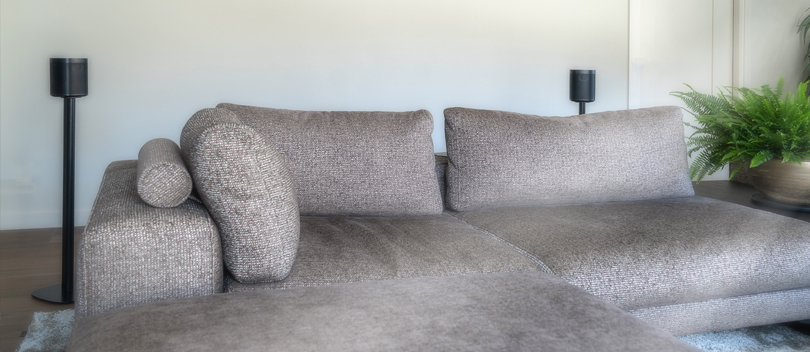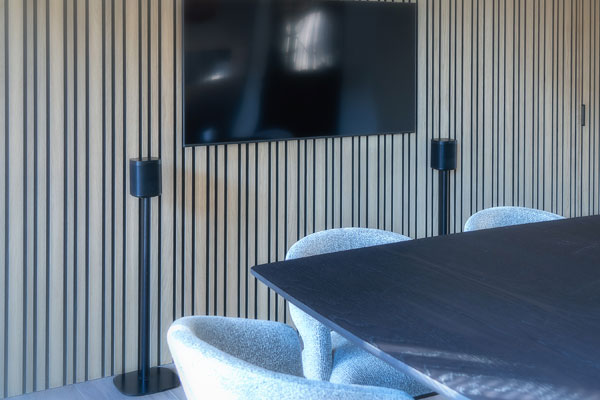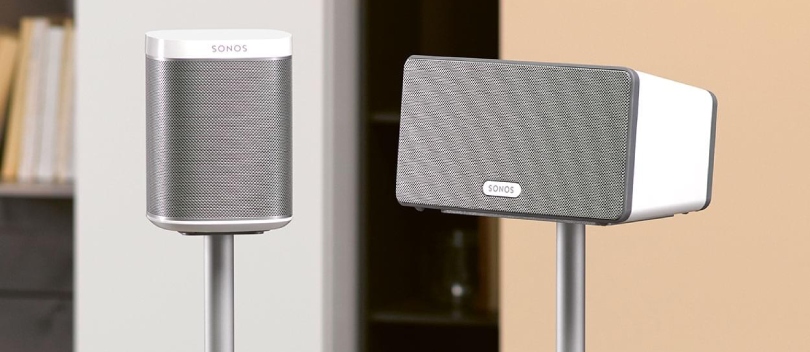
Whether you are watching a film, playing a game or listening to music, creating surround sound with speaker stands is the key to an unrivalled audio experience. As long as you place speaker stands correctly, you can set up an impressive sound system. In this blog, we'll tell you how to go about it and get the most out of your surround set-up.
A surround sound with speakers: what does it involve?
Picture this: you are sitting on the sofa at home and your favourite film starts. The protagonist is running down a busy street, you hear footsteps moving from back to front, the roar of a car tearing past you from left to right and a helicopter circling above you. This is the effect of surround sound - a technique in which speakers are placed at strategic locations around your listening position. Each speaker sends sound from a specific direction, at a specific angle and height, immersing you in the action.
Surround sound creates an immersive sound environment where you feel like the sound is coming from all sides. A standard surround sound system consists of:
- One centre speaker
- Two front speakers (left and right)
- Two rear speakers (left and right)
- One subwoofer

Most common surround installations
You can set up your surround system in different ways, depending on the size of the room, the desired sound experience and your budget. 5.1 and 7.1 are the most common installations. The numbers indicate how many audio points a surround system consists of. Let's take a closer look at this:
5.1 surround sound
A 5.1 system is considered the standard for surround sound and is designed to put you right in the middle of the action. This system uses five sound channels and one subwoofer to create a great sound. With three speakers in front of you and two behind you, the sound is dispersed so you really feel like you are surrounded by the sound.
7.1 surround sound
A 7.1 system goes a step further by adding two additional sound channels, providing an even richer and more detailed audio experience. These extra channels fill in any gaps in the sound field, immersing you even more in the action. Instead of just front and rear speakers, you now have side speakers that distribute sound more accurately and realistically around you.
To create your own surround sound system
When you go to the cinema, there are a number of speakers - as many as 64 in some cases - placed at strategic locations in the room to project sound in every direction. Although you know this experience mainly from the cinema, you can also create an immersive surround sound experience at home with the right speakers in the right place. How to make such a home cinema yourself we tell you below:
Centre speaker
The centre speaker is important for conversational sound and is located directly in front of your listening position, usually below or above your TV. Place it at ear level for best results.
Front speakers (left and right)
Together with the centre speaker, these speakers form the front sound. Place the left and right speakers on either side of your TV, equidistant from the listening position. Use the stands to place them at ear level and turn them slightly inwards towards the listening position.
Rear speakers (left and right)
The rear speakers provide the surround effects and should be placed behind the listening position. They should be placed slightly higher than ear level, approximately at 120 to 130 degrees to the listening position. Again, use stands that you can adjust in height to achieve this. The speakers should face the listening position.
Subwoofer
The subwoofer provides the low frequencies and bass sounds. Place it on the floor, preferably in a corner of the room, for the best sound distribution. Subwoofer placement is less important than that of the other speakers because low frequencies are less directional.

Additional tips for optimum sound quality
- Distance and angle: Make sure the distance between the speakers and the listening position is the same to create a balanced sound. Use a tape measure to measure the exact distance.
- Room acoustics: Consider the acoustics of your room. Avoid hard surfaces that can reflect sound and use sound-absorbing materials such as carpets and curtains if necessary.
- Calibration: Many surround sound systems have a calibration function. Use it to adjust the sound levels of each speaker for the best audio experience.
Choose Vebos for your surround sound with speaker stands
Now that you know how a surround system works, it's time for the fun part: putting together your own home cinema system. Discover our selection of high-quality surround speaker stands that will significantly enhance your viewing and listening experience. Thus, you will find within our range:
Want to buy a speaker stand for your surround sound system? Whether you are a film fanatic or music lover, you will find the perfect surround speaker for your space here!
